Bin Tang
Pose as a Modality: A Psychology-Inspired Network for Personality Recognition with a New Multimodal Dataset
Mar 17, 2025Abstract:In recent years, predicting Big Five personality traits from multimodal data has received significant attention in artificial intelligence (AI). However, existing computational models often fail to achieve satisfactory performance. Psychological research has shown a strong correlation between pose and personality traits, yet previous research has largely ignored pose data in computational models. To address this gap, we develop a novel multimodal dataset that incorporates full-body pose data. The dataset includes video recordings of 287 participants completing a virtual interview with 36 questions, along with self-reported Big Five personality scores as labels. To effectively utilize this multimodal data, we introduce the Psychology-Inspired Network (PINet), which consists of three key modules: Multimodal Feature Awareness (MFA), Multimodal Feature Interaction (MFI), and Psychology-Informed Modality Correlation Loss (PIMC Loss). The MFA module leverages the Vision Mamba Block to capture comprehensive visual features related to personality, while the MFI module efficiently fuses the multimodal features. The PIMC Loss, grounded in psychological theory, guides the model to emphasize different modalities for different personality dimensions. Experimental results show that the PINet outperforms several state-of-the-art baseline models. Furthermore, the three modules of PINet contribute almost equally to the model's overall performance. Incorporating pose data significantly enhances the model's performance, with the pose modality ranking mid-level in importance among the five modalities. These findings address the existing gap in personality-related datasets that lack full-body pose data and provide a new approach for improving the accuracy of personality prediction models, highlighting the importance of integrating psychological insights into AI frameworks.
Improving Multi-Label Contrastive Learning by Leveraging Label Distribution
Jan 31, 2025



Abstract:In multi-label learning, leveraging contrastive learning to learn better representations faces a key challenge: selecting positive and negative samples and effectively utilizing label information. Previous studies selected positive and negative samples based on the overlap between labels and used them for label-wise loss balancing. However, these methods suffer from a complex selection process and fail to account for the varying importance of different labels. To address these problems, we propose a novel method that improves multi-label contrastive learning through label distribution. Specifically, when selecting positive and negative samples, we only need to consider whether there is an intersection between labels. To model the relationships between labels, we introduce two methods to recover label distributions from logical labels, based on Radial Basis Function (RBF) and contrastive loss, respectively. We evaluate our method on nine widely used multi-label datasets, including image and vector datasets. The results demonstrate that our method outperforms state-of-the-art methods in six evaluation metrics.
SSFam: Scribble Supervised Salient Object Detection Family
Sep 07, 2024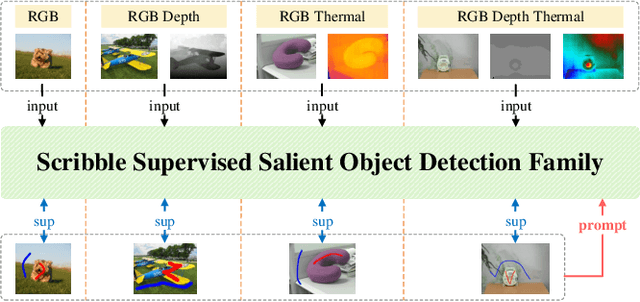
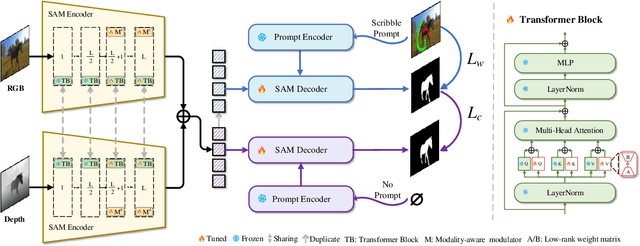
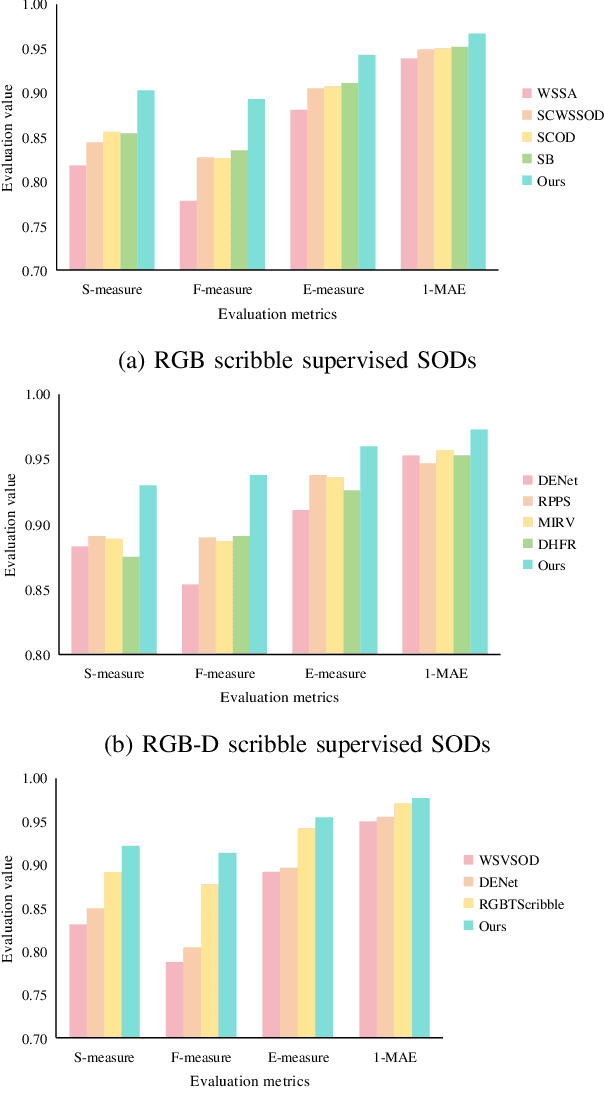
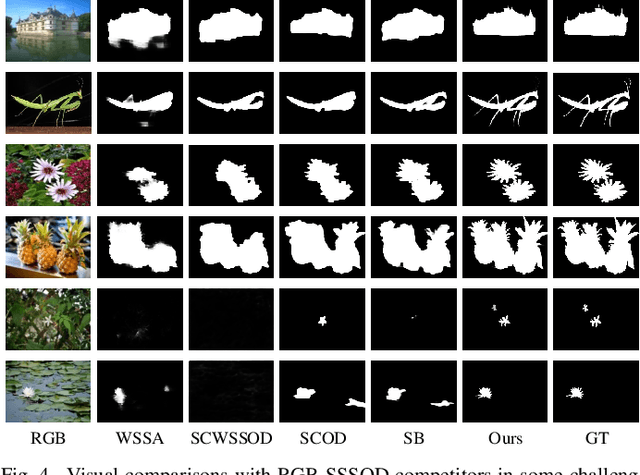
Abstract:Scribble supervised salient object detection (SSSOD) constructs segmentation ability of attractive objects from surroundings under the supervision of sparse scribble labels. For the better segmentation, depth and thermal infrared modalities serve as the supplement to RGB images in the complex scenes. Existing methods specifically design various feature extraction and multi-modal fusion strategies for RGB, RGB-Depth, RGB-Thermal, and Visual-Depth-Thermal image input respectively, leading to similar model flood. As the recently proposed Segment Anything Model (SAM) possesses extraordinary segmentation and prompt interactive capability, we propose an SSSOD family based on SAM, named SSFam, for the combination input with different modalities. Firstly, different modal-aware modulators are designed to attain modal-specific knowledge which cooperates with modal-agnostic information extracted from the frozen SAM encoder for the better feature ensemble. Secondly, a siamese decoder is tailored to bridge the gap between the training with scribble prompt and the testing with no prompt for the stronger decoding ability. Our model demonstrates the remarkable performance among combinations of different modalities and refreshes the highest level of scribble supervised methods and comes close to the ones of fully supervised methods. https://github.com/liuzywen/SSFam
A Fast Power Spectrum Sensing Solution for Generalized Coprime Sampling
Nov 23, 2023Abstract:The growing scarcity of spectrum resources, wideband spectrum sensing is required to process a prohibitive volume of data at a high sampling rate. For some applications, spectrum estimation only requires second-order statistics. In this case, a fast power spectrum sensing solution is proposed based on the generalized coprime sampling. By exploring the sensing vector inherent structure, the autocorrelation sequence of inputs can be reconstructed from sub-Nyquist samples by only utilizing the parallel Fourier transform and simple multiplication operations. Thus, it takes less time than the state-of-the-art methods while maintaining the same performance, and it achieves higher performance than the existing methods within the same execution time, without the need for pre-estimating the number of inputs. Furthermore, the influence of the model mismatch has only a minor impact on the estimation performance, which allows for more efficient use of the spectrum resource in a distributed swarm scenario. Simulation results demonstrate the low complexity in sampling and computation, making it a more practical solution for real-time and distributed wideband spectrum sensing applications.
Multiscale Motion-Aware and Spatial-Temporal-Channel Contextual Coding Network for Learned Video Compression
Oct 19, 2023Abstract:Recently, learned video compression has achieved exciting performance. Following the traditional hybrid prediction coding framework, most learned methods generally adopt the motion estimation motion compensation (MEMC) method to remove inter-frame redundancy. However, inaccurate motion vector (MV) usually lead to the distortion of reconstructed frame. In addition, most approaches ignore the spatial and channel redundancy. To solve above problems, we propose a motion-aware and spatial-temporal-channel contextual coding based video compression network (MASTC-VC), which learns the latent representation and uses variational autoencoders (VAEs) to capture the characteristics of intra-frame pixels and inter-frame motion. Specifically, we design a multiscale motion-aware module (MS-MAM) to estimate spatial-temporal-channel consistent motion vector by utilizing the multiscale motion prediction information in a coarse-to-fine way. On the top of it, we further propose a spatial-temporal-channel contextual module (STCCM), which explores the correlation of latent representation to reduce the bit consumption from spatial, temporal and channel aspects respectively. Comprehensive experiments show that our proposed MASTC-VC is surprior to previous state-of-the-art (SOTA) methods on three public benchmark datasets. More specifically, our method brings average 10.15\% BD-rate savings against H.265/HEVC (HM-16.20) in PSNR metric and average 23.93\% BD-rate savings against H.266/VVC (VTM-13.2) in MS-SSIM metric.
Wideband Spectrum Acquisition for UAV Swarm Using the Sparse Coding Fourier Transform
Aug 14, 2023



Abstract:As the trend towards small, safe, smart, speedy and swarm development grows, unmanned aerial vehicles (UAVs) are becoming increasingly popular for a wide range of applications. In this letter, the challenge of wideband spectrum acquisition for the UAV swarms is studied by proposing a processing method that features lower power consumption, higher compression rates, and a lower signal-to-noise ratio. Our system is equipped with multiple UAVs, each with a different sub-sampling rate. That allows for frequency backetization and estimation based on sparse Fourier transform theory. Unlike other techniques, the collisions and iterations caused by non-sparsity environ-ments are considered. We introduce sparse coding Fourier transform to address these issues. The key is to code the entire spectrum and decode it through spectrum correlation in the code. Simulation results show that our proposed method performs well in acquiring both narrowband and wideband signals simultaneously, compared to the other methods.
Wideband Power Spectrum Sensing: a Fast Practical Solution for Nyquist Folding Receiver
Aug 14, 2023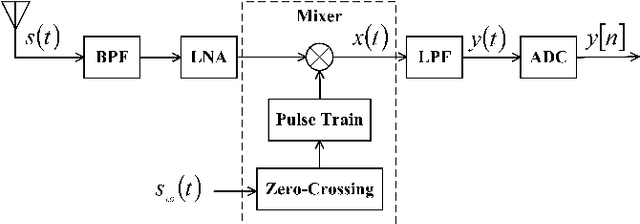
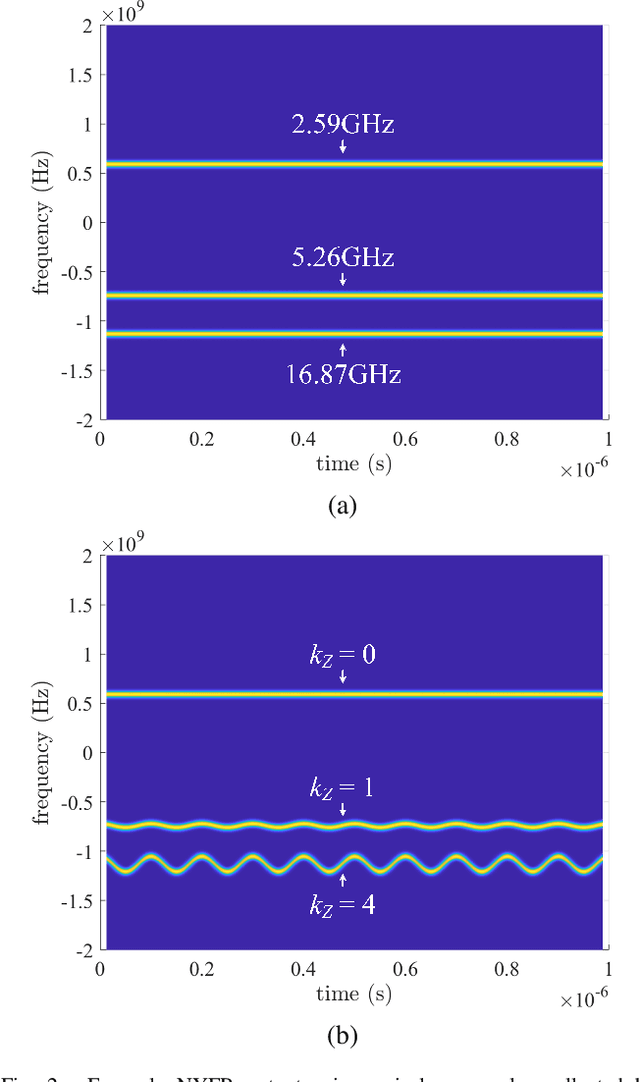
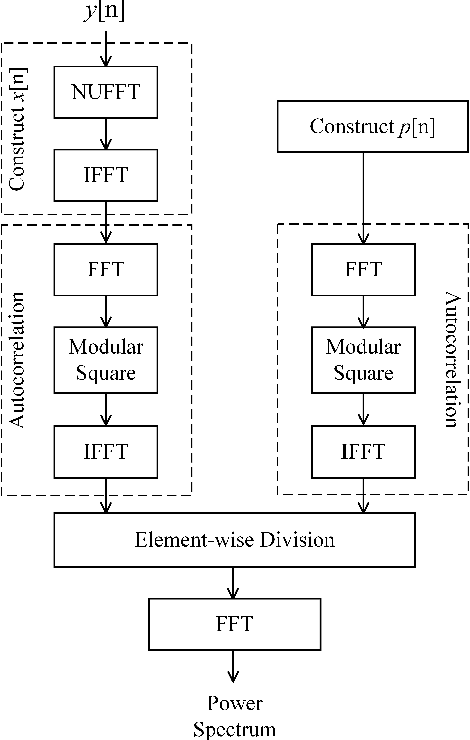
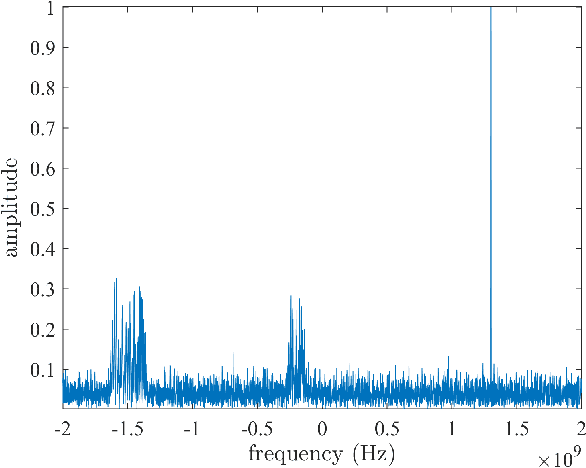
Abstract:The limited availability of spectrum resources has been growing into a critical problem in wireless communications, remote sensing, and electronic surveillance, etc. To address the high-speed sampling bottleneck of wideband spectrum sensing, a fast and practical solution of power spectrum estimation for Nyquist folding receiver (NYFR) is proposed in this paper. The NYFR architectures is can theoretically achieve the full-band signal sensing with a hundred percent of probability of intercept. But the existing algorithm is difficult to realize in real-time due to its high complexity and complicated calculations. By exploring the sub-sampling principle inherent in NYFR, a computationally efficient method is introduced with compressive covariance sensing. That can be efficient implemented via only the non-uniform fast Fourier transform, fast Fourier transform, and some simple multiplication operations. Meanwhile, the state-of-the-art power spectrum reconstruction model for NYFR of time-domain and frequency-domain is constructed in this paper as a comparison. Furthermore, the computational complexity of the proposed method scales linearly with the Nyquist-rate sampled number of samples and the sparsity of spectrum occupancy. Simulation results and discussion demonstrate that the low complexity in sampling and computation is a more practical solution to meet the real-time wideband spectrum sensing applications.
Distributed UAV Swarm Augmented Wideband Spectrum Sensing Using Nyquist Folding Receiver
Aug 14, 2023Abstract:Distributed unmanned aerial vehicle (UAV) swarms are formed by multiple UAVs with increased portability, higher levels of sensing capabilities, and more powerful autonomy. These features make them attractive for many recent applica-tions, potentially increasing the shortage of spectrum resources. In this paper, wideband spectrum sensing augmented technology is discussed for distributed UAV swarms to improve the utilization of spectrum. However, the sub-Nyquist sampling applied in existing schemes has high hardware complexity, power consumption, and low recovery efficiency for non-strictly sparse conditions. Thus, the Nyquist folding receiver (NYFR) is considered for the distributed UAV swarms, which can theoretically achieve full-band spectrum detection and reception using a single analog-to-digital converter (ADC) at low speed for all circuit components. There is a focus on the sensing model of two multichannel scenarios for the distributed UAV swarms, one with a complete functional receiver for the UAV swarm with RIS, and another with a decentralized UAV swarm equipped with a complete functional receiver for each UAV element. The key issue is to consider whether the application of RIS technology will bring advantages to spectrum sensing and the data fusion problem of decentralized UAV swarms based on the NYFR architecture. Therefore, the property for multiple pulse reconstruction is analyzed through the Gershgorin circle theorem, especially for very short pulses. Further, the block sparse recovery property is analyzed for wide bandwidth signals. The proposed technology can improve the processing capability for multiple signals and wide bandwidth signals while reducing interference from folded noise and subsampled harmonics. Experiment results show augmented spectrum sensing efficiency under non-strictly sparse conditions.
Scribble-Supervised RGB-T Salient Object Detection
Mar 17, 2023Abstract:Salient object detection segments attractive objects in scenes. RGB and thermal modalities provide complementary information and scribble annotations alleviate large amounts of human labor. Based on the above facts, we propose a scribble-supervised RGB-T salient object detection model. By a four-step solution (expansion, prediction, aggregation, and supervision), label-sparse challenge of scribble-supervised method is solved. To expand scribble annotations, we collect the superpixels that foreground scribbles pass through in RGB and thermal images, respectively. The expanded multi-modal labels provide the coarse object boundary. To further polish the expanded labels, we propose a prediction module to alleviate the sharpness of boundary. To play the complementary roles of two modalities, we combine the two into aggregated pseudo labels. Supervised by scribble annotations and pseudo labels, our model achieves the state-of-the-art performance on the relabeled RGBT-S dataset. Furthermore, the model is applied to RGB-D and video scribble-supervised applications, achieving consistently excellent performance.
HRTransNet: HRFormer-Driven Two-Modality Salient Object Detection
Jan 08, 2023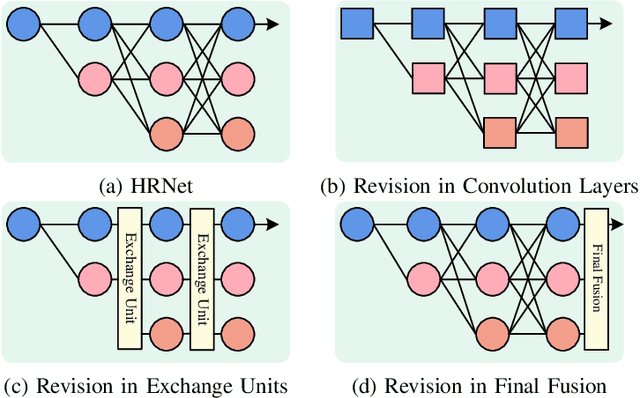

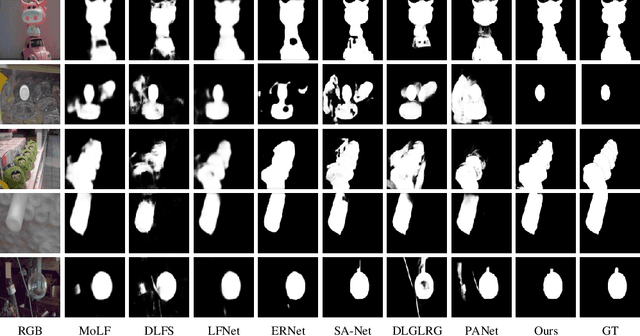
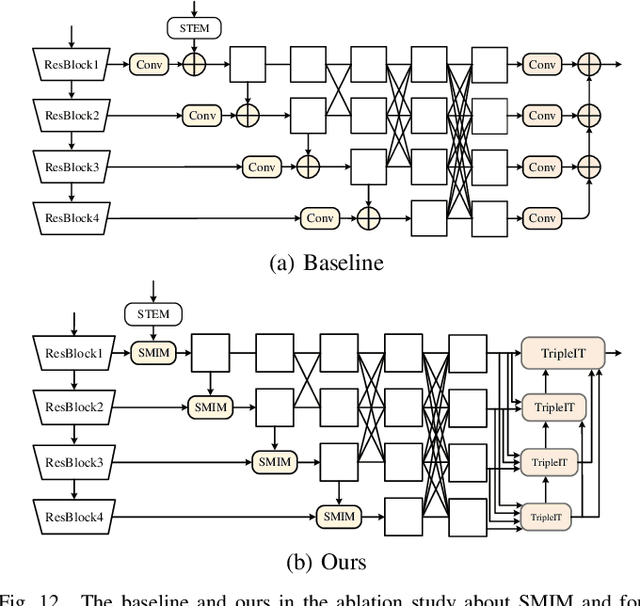
Abstract:The High-Resolution Transformer (HRFormer) can maintain high-resolution representation and share global receptive fields. It is friendly towards salient object detection (SOD) in which the input and output have the same resolution. However, two critical problems need to be solved for two-modality SOD. One problem is two-modality fusion. The other problem is the HRFormer output's fusion. To address the first problem, a supplementary modality is injected into the primary modality by using global optimization and an attention mechanism to select and purify the modality at the input level. To solve the second problem, a dual-direction short connection fusion module is used to optimize the output features of HRFormer, thereby enhancing the detailed representation of objects at the output level. The proposed model, named HRTransNet, first introduces an auxiliary stream for feature extraction of supplementary modality. Then, features are injected into the primary modality at the beginning of each multi-resolution branch. Next, HRFormer is applied to achieve forwarding propagation. Finally, all the output features with different resolutions are aggregated by intra-feature and inter-feature interactive transformers. Application of the proposed model results in impressive improvement for driving two-modality SOD tasks, e.g., RGB-D, RGB-T, and light field SOD.https://github.com/liuzywen/HRTransNet
 Add to Chrome
Add to Chrome Add to Firefox
Add to Firefox Add to Edge
Add to Edge